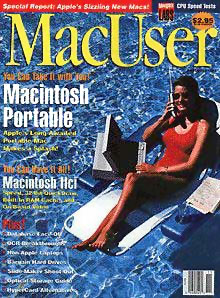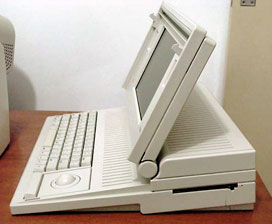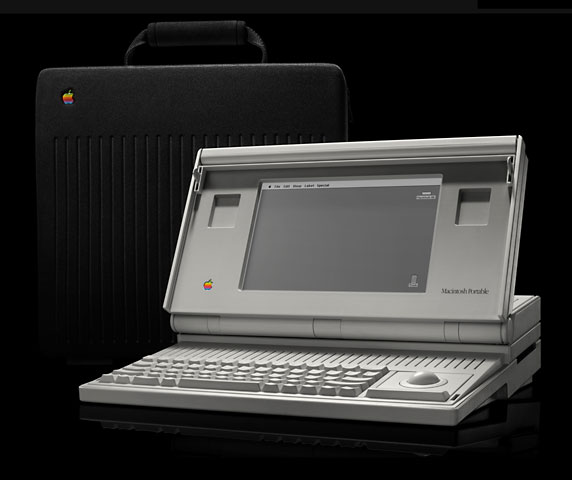You might not believe the cover from the November 1989 MacUser. They considered the Mac Portable so sexy it was photographed with a swimsuit model for the front cover! (Or maybe so unsexy it needed this treatment.)
 When the Mac Portable was introduced, it had the same clock speed as the fastest prior Mac (it was introduced at the same time as the 25 MHz Mac IIci). At that time, many Mac users who needed a field computer were buying Compaq 286-based laptops with DOS 4.01 (and sometimes Windows 2.1).
When the Mac Portable was introduced, it had the same clock speed as the fastest prior Mac (it was introduced at the same time as the 25 MHz Mac IIci). At that time, many Mac users who needed a field computer were buying Compaq 286-based laptops with DOS 4.01 (and sometimes Windows 2.1).
It was portable, but it was no lightweight. The 16-17 pound Mac Portable never set the world on fire. It had a crystal clear 9.8″ 1-bit 640 x 400 pixel active matrix screen, a 16 MHz 68000 CPU, and a front-mounted handle (which doubled as a lock to keep the lid down). The best thing about the Portable was probably the up-to-10-hour lead-acid battery. (No memory effect!) Options included an internal modem and a numeric keypad or a trackball.
 Color display? Aura Systems made ScuzzyGraph II, a SCSI peripheral that provided 8-color video for people who didn’t want to buy (or couldn’t afford) a Mac II. In 1989, ScuzzyGraph sold for $995 to $2,495 depending on resolution.
Color display? Aura Systems made ScuzzyGraph II, a SCSI peripheral that provided 8-color video for people who didn’t want to buy (or couldn’t afford) a Mac II. In 1989, ScuzzyGraph sold for $995 to $2,495 depending on resolution.
The Portable draws the same amount of power whether shut down or asleep, so it is generally best to put it to sleep unless it won’t be used again for several days.
Energy saving tricks include turning off the speaker, trying to open all your files at once to minimize disk access, using a RAM Disk, and putting the hard drive to sleep manually. Rumors to the contrary, it makes no difference at all in terms of energy use what desktop pattern you use.
The huge size and massive weight of the otherwise-impressive Portable make us call it a Limited Mac.
The Portable was the first Mac to ship with a preformatted hard drive (and the only portable Mac with a 3.5″ hard drive) and a preinstalled operating system. Along with the Mac IIci, it was one of the first Macs to user surface mount technology.
MacUser commented that this was “by far the most complex piece of machinery devised for sale by Apple computer” (Nov. 1989). Benchmarks showed it significantly faster than the 8 MHz Mac SE, and nearly as fast as the 16 MHz 68020-based Mac II on some tests.
The Portable was upgraded with a backlit screen; more, less-expensive RAM (2-4 MB standard); and a lower price in February 1991.
When buying a used Portable, be sure to get all the memory you need, since it’s difficult to come by nowadays, and don’t expect it to include a working battery. Bear in mind that the Portable only supports up to 9 MB of RAM and only functions in 24-bit mode. To get the most out of that memory, consider using RAM Charger 8.1, which offers better memory management than the Mac OS.
- Got a Portable or PowerBook? Consider joining the PowerBooks email list.
- Our System 6 List is for those using Mac System 6.
Details
- introduced 1989.09.20 at $6,500 ($7,300 with hard drive); replaced by backlit model 1991.02
- Gestalt ID: 10
- model number: M5120
- Code Names: Laguna, Malibu
Mac OS
- requires System 6.0.4 to 7.5.5 (see caution on wake up crash caused by newer drivers)
- addressing: 24-bit only
Core System
- CPU: 16 MHz 68HC000
- ROM: 256 KB
- RAM: 1 MB, expandable to 9 MB using a special 30ns SRAM card (only one slot)
Performance
- 2.0, relative to SE
- 1.3 MIPS
- 2.15, Speedometer 3
- see Benchmarks: Portable for more details
Graphics
- display: 9.8″ 1-bit 640 x 400 77 ppi
Drives
- Hard drive: 40 MB 3.5″ hard drive standard, uses special low power Connor drive with special connector (can only use standard SCSI drives with a special, costly adapter)
- floppy drive: 1.4 MB double-sided
Expansion
- ADB ports: 1 for keyboard and mouse
- serial ports: 2 DIN-8 RS-422 ports on back of computer
- SCSI ports: DB-25 connector on back of computer
- batteries: 9V “transistor” battery for PRAM, 6V 5Ah sealed lead-acid for power (over 2 lb.)
- proprietary modem slot
Physical
- size (HxWxD): 4.05″ x 15.25″ x 14.83″
- Weight: 15.8 lb.
- power supply: 5W, 13 amps
Tips
- One user has reported success replacing a dead Conner CP-3045 hard drive with a standard Conner CP-3044 that had been formatted under System 6.0.8.
- You can use a PowerBook 100-series AC adapter to run the Portable without the internal lead-acid battery. However, you will lose PRAM settings if you unplug the power (date, time, cache size, etc.)
- Godwin <godwin@unixg.ubc.ca> says, “If the acid battery dies, one can bypass it and convert the Portable into a luggable. One needs tw AC adapters – the original one and a 9V DC adapter. Take out the 9V DC battery and replace it with a 9V 1A power adapter. Then remove the battery and cover (there is a switch at the battery cover which we need to disable). Plug the two adapters in and viola! one of the sleekest Macs on anyone’s desktop!”
Online Resources
- Creating Classic Mac Boot Floppies in OS X, Paul Brierley, The ‘Book Beat, 2008.08.07. Yes, it is possible to create a boot floppy for the Classic Mac OS using an OS X Mac that doesn’t have Classic. Here’s how.
- The misunderstood Macintosh Portable, Dan Knight, Mac Musings, 2009.01.19. Often ridiculed for its nearly 16 lb. weight, people forget that the Mac Portable wasn’t designed to be a laptop computer.
- Extended coverage for MacBook Air hinge, Mac Portable Retrospective, iBook as netbook, and more, The ‘Book Review, 2009.09.25. Also building a Pismo from 3 dead ones, upgrading RAM, buyers interested in Apple tablet, first USB 3.0 ExpressCard adapter, bargain ‘Books from $179 to $2,294, and more.
- Why You Should Partition Your Mac’s Hard Drive, Dan Knight, Mac Musings, 2008.12.11. “At the very least, it makes sense to have a second partition with a bootable version of the Mac OS, so if you have problems with your work partition, you can boot from the ’emergency’ partition to run Disk Utility and other diagnostics.”
- A brief history of portable computing: From Dynabook to netbooks, Dan Knight, Mac Musings, 2008.11.06. 40 years ago Alan Kay dreamt of a two pound handheld computer. Portables have made a lot of changes since 1981, but haven’t yet matched the Dynabook.
- Attractive and ugly Macs, discontinued MacBook Pro value, and writing with TextEdit, Charles W Moore, Miscellaneous Ramblings, 2008.10.30. Readers weigh in on the good, the bad, and the ugly of Macintosh design over the past 24 years.
- Portable Mac as primary vs. secondary computer, looking at ThinkPad design, and more, Charles W Moore, Miscellaneous Ramblings, 2008.09.17. Also learning from the Mac Portable, upgrading a PowerBook 5300, another free app to assure maintenance routines are run, and more.
- Bring back the Macintosh Portable, Charles W Moore, ‘Book Value, 2008.09.09. Not to fault today’s MacBooks, but there’s something to be said for a no compromise, very expandable, portable Macintosh as well.
- The Compressed Air Keyboard Repair, Charles W Moore, Miscellaneous Ramblings, 2008.07.24. If your keyboard isn’t working as well as it once did, blasting under the keys with compressed air may be the cure.
- The Macintosh Portable started a notebook revolution, Carl Nygren, Classic Macs in the Intel Age, 2008.07.03. Before Apple introduced the Mac Portable, notebook computers were text-based and ran MS-DOS. Ever since, graphical interfaces have been the norm for laptops.
- A Vintage Mac Network Can Be as Useful as a Modern One, Carl Nygren, My Turn, 2008.04.08. Old Macs can exchange data and share an Internet connection very nicely using Apple’s old LocalTalk networking.
- Vintage Mac Networking and File Exchange, Adam Rosen, Adam’s Apple, 2007.12.19. How to network vintage Macs with modern Macs and tips on exchanging files using floppies, Zip disks, and other media.
- Solving Mac Startup Problems, Adam Rosen, Adam’s Apple, 2007.12.12. When your old Mac won’t boot, the most likely culprits are a dead PRAM battery or a failed (or failing) hard drive.
- Simple Macs for Simple Tasks, Tommy Thomas, Welcome to Macintosh, 2007.10.19. Long live 680×0 Macs and the classic Mac OS. For simple tasks such as writing, they can provide a great, low distraction environment.
- Mac System 7.5.5 Can Do Anything Mac OS 7.6.1 Can, Tyler Sable, Classic Restorations, 2007.06.04. Yes, it is possible to run Internet Explorer 5.1.7 and SoundJam with System 7.5.5. You just need to have all the updates – and make one modification for SoundJam.
- Format Any Drive for Older Macs with Patched Apple Tools, Tyler Sable, Classic Restorations, 2007.04.25. Apple HD SC Setup and Drive Setup only work with Apple branded hard drives – until you apply the patches linked to this article.
- Making floppies and CDs for older Macs using modern Macs, Windows, and Linux PCs, Tyler Sable, Classic Restorations, 2007.03.15. Older Macs use HFS floppies and CDs. Here are the free resources you’ll need to write floppies or CDs for vintage Macs using your modern computer.
- Poseidon Adventure, RetroMacCast, 2006.03.04. James and John discuss the Mac Portable and talk to Low End Mac’s Tommy Thomas.
- Jag’s House, where older Macs still rock, Tommy Thomas, Welcome to Macintosh, 2006.09.25. Over a decade old, Jag’s House is the oldest Mac website supporting classic Macs and remains a great resource for vintage Mac users.
- 30 days of old school computing: Increasing battery life with a RAM disk, Ted Hodges, Vintage Mac Living, 2006.09.14. When using the hard drive, the old battery ran out of juice within 30 minutes, but running from a RAM disk it still has a 50% charge after half an hour.
- Edu-iMac too compromised, Mac Portables return to mothership, SheepShaver unstable, and more, Dan Knight, Low End Mac Mailbag, 2006.07.12. Thoughts on the education iMac, the Mac Portable, and the value of a Mac Plus in 2006. Also SheepShaver feedback, OS X ligature problems, and MP3 software for OS 8.
- Vintage Macs with System 6 run circles around 3 GHz Windows 2000 PC, Tyler Sable, Classic Restorations, 2006.07.06. Which grows faster, hardware speed or software bloat? These benchmarks show vintage Macs let you be productive much more quickly than modern Windows PCs.
- Compact Flash with SCSI Macs, PB 1400 CD-RW upgrade problems, and Web incompatibilities, Dan Knight, Low End Mac Mailbag, 2006.06.16. Suggested ways to use Compact Flash with vintage Macs and PowerBooks, problems getting CD-RW to work with a PowerBook 1400, and more thoughts on website incompatibilities.
- Moving files from your new Mac to your vintage Mac, Paul Brierley, The ‘Book Beat, 2006.06.13. Old Macs use floppies; new ones don’t. Old Macs use AppleTalk; Tiger doesn’t support it. New Macs can burn CDs, but old CD drives can’t always read CD-R. So how do you move the files?
- System 7.5 and Mac OS 7.6: The beginning and end of an era, Tyler Sable, Classic Restorations, 2006.02.15. System 7.5 and Mac OS 7.6 introduced many new features and greater modernity while staying within reach of most early Macintosh models.
- System 7: Bigger, better, more expandable, and a bit slower than System 6, Tyler Sable, Classic Restorations, 2006.01.04. The early versions of System 7 provide broader capability for modern tasks than System 6 while still being practical for even the lowliest Macs.
- Web browser tips for the classic Mac OS, Nathan Thompson, Embracing Obsolescence, 2006.01.03. Tips on getting the most out of WaMCom, Mozilla, Internet Explorer, iCab, Opera, and WannaBe using the classic Mac OS.
- The Joy of Six: Apple’s fast, svelte, reliable, and still usable System 6, Tyler Sable, Classic Restorations, 2005.12.06. System 6 was small enough to run quickly from an 800K floppy yet powerful enough to support 2 GB partitions, 24-bit video, and the Internet.
- Which system software is best for my vintage Mac?, Tyler Sable, Classic Restorations, 2005.11.22. Which system software works best depends to a great extent on just which Mac you have and how much RAM is installed.
- Mac Portable, Tom, Macreate, 2004.12.21. “The Portable was a no compromise machine, much to the delight of John Louis Gassée.”
- Get Your Compact Mac on the Web, Jag’s House
- Macintosh Portable: Apple’s first portable Mac, Roger Sinasohn
. “There is something decidedly odd about the Macintosh Portable – If you do not have a working, charged battery installed, it simply will not boot.”
- PowerBook history, Adam Robert Guha, Apple Archive, 2000.05.12. A history of portable Macs from 1989 through 1996.
- Networking a Mac Plus to an iMac, Jag’s House. Key component is a SCSI-ethernet adapter, which will work with a Portable as well.
- Faster browsing on older Macs, Mac Online Tech Journal
- Old Macs on the internet, The Web Toolbox
- Email lists: PowerBooks, Classic Macs Digest
- Links to System 6.0.8 and 7.0.1
- Software Compatible with 68000 CPU
- Apple introduces two new Macs, MacTech, 1989.11. A first look at the Mac IIci and Portable.
- SCSI pinout – the Mac Portable has a unique SCSI configuration
- Mac Portables for sale, Houlton’s Offering of Complete Portables
- Portable parts for sale, Houlton’s Portable Options Page
Online Profiles
Battery/Power Links
- Replacing the battery in a Mac Portable, JAG’s site
- Review: Power-Sonic PSG-650 battery
Cautions
- Never use a version of Apple HD SC Setup newer than 7.3.1 (which comes with System 7.0.1) or your Portable will crash while waking from sleep mode.
- The Mac Portable does not provide SCSI termination power, depending on external SCSI devices to provide it. For more details, see SCSI Termination Power.
- Macs with black-and-white only displays (1-bit, no grays) may find Netscape Navigator 3 makes it impossible to view some pages and sites. The workaround is to use Navigator 2.
- Battery becomes unusable if discharged below 5.4V; keep it charged!
- Hard drive will not spin up without a charged battery installed.
- Modem port limited to 57.6 kbps (printer port may be faster); use of a 56k modem on the modem port may limit throughput. See 56k modem page.
- Apple has discontinued support and parts orders for this model. You may be able to find dealers with parts inventory either locally or on our parts and service list.
Short link: http://goo.gl/q9sGII
searchword: macportable



